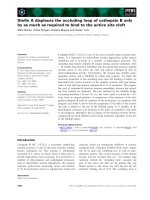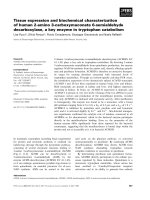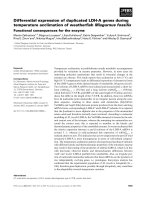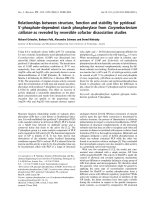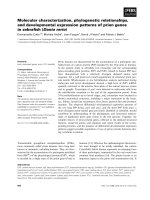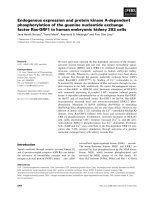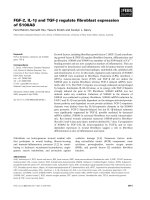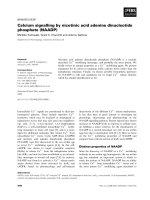Báo cáo khoa học: Regulated expression by PPARa and unique localization of 17b-hydroxysteroid dehydrogenase type 11 protein in mouse intestine and liver pdf
Bạn đang xem bản rút gọn của tài liệu. Xem và tải ngay bản đầy đủ của tài liệu tại đây (893.93 KB, 11 trang )
Regulated expression by PPARa and unique localization
of 17b-hydroxysteroid dehydrogenase type 11 protein
in mouse intestine and liver
Yasuhide Yokoi*, Yuka Horiguchi*, Makoto Araki and Kiyoto Motojima
Department of Biochemistry, Meiji Pharmaceutical University, Kiyose, Tokyo, Japan
Keywords
hydroxysteroid dehydrogenase;
immunocytochemistry; intestine; lipid
droplet; proliferator-activated receptor
Correspondence
K. Motojima, Department of Biochemistry,
Meiji Pharmaceutical University, 2-522-1
Noshio, Kiyose, Tokyo 204-8588, Japan
Fax: +81 42 495 8474
Tel: +81 42 495 8474
E-mail:
*These authors contributed equally to this
work
(Received 30 May 2007, revised 21 July
2007, accepted 24 July 2007)
doi:10.1111/j.1742-4658.2007.06005.x
17b-Hydroxysteroid dehydrogenase type 11 (17b-HSD11) is a member of
the short-chain dehydrogenase ⁄ reductase family involved in the activation
and inactivation of sex steroid hormones. We recently identified
17b-HSD11 as a gene that is efficiently regulated by peroxisome proliferator-activated receptor-a PPARa in the intestine and the liver [Motojima K
(2004) Eur J Biochem 271, 4141–4146]. In this study, we characterized
17b-HSD11 at the protein level to obtain information about its physiologic
role in the intestine and liver. For this purpose, specific antibodies against
17b-HSD11 were obtained. Western blotting analysis showed that administration of a peroxisome proliferator-activated receptor-a agonist induced
17b-HSD11 protein in the jejunum but not in the colon, and to a much
higher extent than in the liver of mice. A subcellular localization study
using Chinese hamster ovary cells and green fluorescent protein-tagged
17b-HSD11 showed that it was mostly localized in the endoplasmic reticulum under normal conditions, whereas it was concentrated on lipid droplets
when they were induced. A pulse-chase experiment suggested that
17b-HSD11 was redistributed to the lipid droplets via the endoplasmic
reticulum. Immunohistochemical analysis using tissue sections showed that
17b-HSD11 was induced mostly in intestinal epithelia and hepatocytes,
with heterogeneous localization both in the cytoplasm and in vesicular
structures. A subcellular fractionation study of liver homogenates confirmed that 17b-HSD11 was localized mostly in the endoplasmic reticulum
when mice were fed a normal diet, but was distributed in both the endoplasmic reticulum and the lipid droplets of which formation was induced
by feeding a diet containing a proliferator-activated receptor-a agonist.
Taken together, these data indicate that 17b-HSD11 localizes both in the
endoplasmic reticulum and in lipid droplets, depending on physiologic conditions, and that lipid droplet 17b-HSD11 is not merely an endoplasmic
reticulum contaminant or a nonphysiologically associated protein in the
cultured cells, but a bona fide protein component of the membranes of
both intracellular compartments.
Peroxisome proliferator-activated receptor-a (PPARa)
is one of the members of the nuclear hormone receptor
superfamily, and functions as a ligand-dependent tran-
scription factor [1]. It is now well accepted that
PPARa is particularly important in lipid catabolism in
the liver, upregulating the expression of a variety of
Abbreviations
ACSL3, long-chain acyl-CoA synthetase 3; ADRP, adipose differentiation-related protein; 17b-HSD11, 17b-hydroxysteroid dehydrogenase
type 11; CHO, Chinese hamster ovary; ER, endoplasmic reticulum; FABP, fatty acid-binding protein; GFP, green fluorescent protein; L-FABP,
liver-type FABP; LD, lipid droplet; PNS, postnuclear supernatant; PPARa, proliferator-activated receptor-a; TIP47, tail-interacting protein 47.
FEBS Journal 274 (2007) 4837–4847 ª 2007 The Authors Journal compilation ª 2007 FEBS
4837
17-b-Hydroxysteroid dehydrogenase type 11
Y. Yokoi et al.
genes that encode proteins involved in fatty acid transport, b-oxidation, and lipoprotein metabolism [2,3].
However, PPARa is expressed not only in the liver but
also in other organs [4]. We have been interested in the
extrahepatic functions of PPARa, and recently identified the gene encoding 17b-hydroxysteroid dehydrogenase type 11 (17b-HSD11) as a gene that is very
effectively PPARa-regulated in the intestine [5]. 17bHSD11 is a member of the short-chain dehydrogenase ⁄ reductase superfamily (family member 8), and it
interconverts 17b-OH ⁄ 17-oxosteroids [6]. Thus, the
activities of the androgen metabolite pair androsterone ⁄ 3,17-androstanediol and abundant expression in
steroidogenic tissues such as placenta and gonads have
been described [7]. 17b-HSD11 also has a protein
domain of glucose ⁄ ribitol dehydrogenase, and its wide
substrate specificities have been reported [8,9]. Thus,
high-level induction of 17b-HSD11 in the intestine and
liver by PPARa may have a different physiologic significance from that in sex hormone metabolism.
Elucidation of the subcellular distribution of 17bHSD11 will be important in uncovering other functions, but this has not yet been firmly demonstrated.
Chai et al. [7] first suggested that human 17b-HSD11
was localized in the cytoplasm, on the basis of observations made using 17b-HSD11 tagged with green
fluorescent protein (GFP) at the N-terminus. Using
proteomics analysis, Fujimoto et al. [10] identified 17bHSD11 as one of the major lipid droplet (LD)-associated proteins in human hepatoma cells when formation
of LDs was artificially induced by incubating the cells
with an excess amount of fatty acids. It might be necessary to carefully examine these previous observations
to clarify the subcellular distribution of 17b-HSD11
from another point of view, because in both cases,
experimental conditions did not reflect in vivo conditions. Addition of an artificial tag sequence at the
N-terminus of 17b-HSD11 might have disturbed the
mechanism of intracellular localization and forced
induction of LDs in the cells, and might have caused
abortive association of proteins on their surfaces.
In this study, we characterized mouse 17b-HSD11
at the protein level, both in cultured cells and in the
tissues of mice, to elucidate its subcellular distribution
under various conditions. For this purpose, we prepared specific antibodies against mouse 17b-HSD11 to
detect endogenous protein: 17b-HSD11 tagged with
GFP at the C-terminus to efficiently detect the protein, and Halo-tagged 17b-HSD11 to follow its redistribution in a pulse-chase experiment. We found that
17b-HSD11 is localized both on the endoplasmic reticulum (ER) and on LDs, depending on physiologic
conditions.
4838
Results
17b-HSD11 protein is greatly induced in the
intestine and liver by a PPARa agonist
To confirm our previous observation at the mRNA
level that 17b-HSD11 was greatly induced in the intestine and liver of mice by administration of a PPARa
agonist, Wy-14 643 [5], the changes in protein levels
were examined by western blotting. For this purpose,
we prepared antibodies in rabbits against both the synthetic peptide corresponding to Ser95 to Glu109 and
the recombinant protein corresponding to Ile19 to
Lys298 expressed in Escherichia coli. The postnuclear
fractions were prepared from the tissues of mice fed a
control diet or one containing Wy-14 643, and the proteins were separated by SDS ⁄ PAGE for western blotting analysis. Both antibodies specifically recognized
the same protein on the SDS ⁄ PAGE gels having a
molecular mass of 34 kDa (Fig. 1A), and a representative result obtained using postnuclear fractions of the
intestinal mucosa and liver and antibodies to recombinant 17b-HSD11 is shown in Fig. 1B. The amounts of
17b-HSD11 protein were markedly induced in both the
mouse intestine and liver by administration of the
PPARa agonist. The induction ratios in both tissues
were greater than 20, and the induced protein level in
the intestinal mucosa was about five times higher than
that in the liver when normalized with the amounts of
proteins analyzed. These results on a protein level are
consistent with our previous findings on mRNA levels
[5]. Thus, 17b-HSD11 is a unique protein whose
expression level is regulated much more efficiently by
PPARa and its ligand in the intestine than in the liver.
17b-HSD11 is distributed only in duodenum and
jejunum
To examine the distribution of the induced 17bHSD11 along the gut, proteins from portions of stomach, duodenum, jejunum, ileum, cecum and colon of
mice fed a diet containing Wy-14 643 were prepared
and analyzed by western blotting using antibodies to
17b-HSD11 and liver fatty acid-binding protein
(L-FABP) [11]. 17b-HSD11 was detected only in duodenum and jejunum, with a similar expression pattern
to that of L-FABP (Fig. 2B). Absence of these proteins in stomach, colon and cecum and restricted
expression at the site of fatty acid absorption suggest
their roles in lipid absorption and metabolism at the
primary site, the small intestine [12]. L-FABP protein
levels in the small intestine were higher in the duodenum than in the jejunum, whereas 17b-HSD11 levels
FEBS Journal 274 (2007) 4837–4847 ª 2007 The Authors Journal compilation ª 2007 FEBS
Y. Yokoi et al.
A
Wy14,643
17-b-Hydroxysteroid dehydrogenase type 11
Peptide
Recombinant
+
M
+
(kDa)
75
stomach
1
50
Western blot
jejunum
5
A
6
ileum
duodenum
8
4
2
3
colon 10
37
7
B
9
caecum
1 2 3 4 5 6 7 8 9 10
17β-HSD11
25
75
L-FABP
50
CBB-stain
37
C
1’ 2’ 3’ 4’ 5’ 6’ 7’ 8’ 9’ 10’
17β-HSD11
L-FABP
25
B
Wy14,643
Liver
+ +
Intestine
+ +
17β-HSD11
CBB-stain
Fig. 2. Expression of 17b-HSD11 protein in the gastrointestinal
tract. (A) The gastrointestinal tract of mice [29] fed a diet containing
Wy-14 643 for 5 days was divided into 10 parts, and the portions
indicated by circles were homogenized to obtain total proteins. (B)
Equal amounts of proteins (20 lg) were separated by SDS ⁄ PAGE,
and expression levels of 17b-HSD11 and L-FABP were analyzed by
western blotting using the specific antibodies. (C) The duodenum
and jejunum [corresponding to parts 3–6 in (A)] of another mouse
that had been treated in the same way were further divided into 10
portions, and the expression levels of 17b-HSD11 and L-FABP in
each portion (1¢ to 10¢) were analyzed by western blotting.
17b-HSD11 colocalized with an ER marker protein
in transfected Chinese hamster ovary (CHO) cells
Fig. 1. Effects of Wy14 643 on protein expression levels of
17b-HSD11 in the liver and intestine of mice. (A) Specificity of the
antibodies to peptide (Peptide) and recombinant protein (Recombinant) against 17b-HSD11. The PNS proteins of the liver from mice
fed a normal diet (–) or one containing a PPARa ligand, Wy-14 643
(–), were separated by SDS ⁄ PAGE and analyzed by western blotting. After analysis, the transferred membrane was stained with
Coomassie Brilliant Blue R250 to ensure equal protein loading. (B)
Comparison of the induction levels of 17b-HSD11 in the liver and
intestine. The same amounts (20 lg) of proteins from the PNS fractions of liver and small intestinal mucosa were analyzed by western
blotting using antibodies to recombinant protein. The transferred
membrane was stained for equal protein loading.
were almost the same in both sites, with a drop at the
boundary between the two sites, showing a biphasic
expression pattern (Fig. 2C).
We next investigated the intracellular location of 17bHSD11 in a model cell system. To efficiently detect
17b-HSD11 in the cell, a plasmid vector expressing
chimeric 17b-HSD11 with GFP or a Myc-tag at the
C-terminus was constructed and transfected into CHO
cells. Confocal fluorescence microscopy examination
detecting indirect immunofluorescence from antibodies
specific for the ER marker protein calnexin [13] and
Myc-tag showed a strong overlap of the signals
(Fig. 3), indicating that 17b-HSD11 is predominantly
localized in the ER. A similar reticular pattern was
observed, consistent with ER localization of 17bHSD11, when it was detected by the indirect immunofluorescence method using a specific antibody against
the protein. These microscopic observations suggested
that 17b-HSD11 is associated with the ER in the transfected CHO cells under normal cell culture conditions.
FEBS Journal 274 (2007) 4837–4847 ª 2007 The Authors Journal compilation ª 2007 FEBS
4839
17-b-Hydroxysteroid dehydrogenase type 11
Y. Yokoi et al.
PI
Calnexin
HSD-Myc
HSD-Myc
Merged (PI + HSD)
Merged(Calnexin + HSD)
Fig. 3. Subcellular localization of 17b-HSD11 in CHO cells. CHO cells
stably expressing the myc-tagged 17b-HSD11at the C-terminus were
fixed and stained with monoclonal antibody to myc and the
fluorescein isothiocyanate-labeled anti-mouse IgG. The cells were
also counterstained with propidium iodide (top left) for nuclei and
with anti-calnexin (top right) for ER localization, using Arexa 594labeled secondary antibodies (red). Areas of colocalization appear as
yellow in the merged images (merged). The bar represents 10 lm.
This result is inconsistent with that of Chai et al. [7],
who used N-terminally tagged protein, and the ER
protein might have been mistargeted to the cytoplasm.
In regard to this, it is of interest to point out the recent
publication by Fujimoto et al. [10], showing that
17b-HSD11 was identified as the third most abundant
protein after adipose differentiation-related protein
(ADRP) and long-chain acyl-CoA synthetase 3
(ACSL3) among 17 major proteins associated with the
LDs formed in the human hepatocyte cell line HuH7.
17b-HSD11 is associated with LDs in CHO cells
To examine the possibility that 17b-HSD11 expressed
in CHO cells is also associated with LDs, as demon4840
strated by Fujimoto et al. [10], we first established the
conditions to induce formation of LDs in CHO cells
by incubating with various concentrations of fatty
acids. In the cells incubated with 200 lm oleic acid for
24–48 h, droplet structures were formed that could be
efficiently stained with Oil Red O (Fig. 4A, upper).
Higher concentrations of fatty acids accelerated the
formation of the LDs, but the toxic effects of fatty
acids on the cells became evident. Therefore, the cells
cultured under normal conditions were transiently
transfected with the 17b-HSD11-GFP expression plasmid, and were then cultured in a medium supplemented with or without 200 lm oleic acid to induce
formation of the LDs. A reticular pattern of GFP
signals was observed in the cytoplasm of the cells in
normal medium, as in Fig. 3, but the pattern underwent a marked change to largely localized signals
around the LDs upon their formation in the transfected cells (Fig. 4A, lower, and Fig. 4B). A large increase
in the signals around the droplets and a significant
decrease in the reticular signals suggested that either
pre-existing 17b-HSD11-GFP (Fig. 4A) and 17bHSD11-Myc (Fig. 4B) on the ER moved out to the
LDs, or that only newly synthesized 17b-HSD11 was
cotranslationally localized and stabilized around the
LDs, although other mechanisms could not be
excluded.
17b-HSD11 on the ER moves to the LDs
To examine whether pre-existing 17b-HSD11 on the
ER stays there or moves out to the LDs upon their
formation, we pulse-labeled 17b-HSD11 on the ER
using a Halo-tag system [14], and detected the changes
in distribution of the labeled protein before and after
the formation of the LDs. To complete pulse-labeling
of the Halo-tagged 17b-HSD11 on the ER, the cells
were exposed to binding dye for 15 min, and were then
washed and induced for LD formation by changing
the culture medium to one containing oleic acid. In
this way, the pre-existing 17b-HSD11 could be clearly
distinguished, by the fluorescent dye covalently bound
to the attached Halo-tag, from the newly synthesized
unlabeled Halo-tag-containing 17b-HSD11. As shown
in Fig. 5, 17b-HSD11 showed a reticular pattern in the
cytoplasm before induction of LD formation, as in
Fig. 3, but most of the labeled 17b-HSD11 was found
around the LDs after LD formation. This result clearly
indicated that pre-existing 17b-HSD11 on the ER
moved to the LDs, although whether it moved during
or after the formation of the LDs was not clarified in
this study. It is also noteworthy that the reticular
signals were significantly decreased upon formation of
FEBS Journal 274 (2007) 4837–4847 ª 2007 The Authors Journal compilation ª 2007 FEBS
Y. Yokoi et al.
Fig. 4. Localization of 17b-HSD11 around the LDs. (A) Induction of
LD formation and distribution of 17b-HSD11 in CHO cells. The cells
were incubated with or without 200 lM oleic acid for 48 h, and
stained with Oil Red O. Distributions of 17b-HSD11 in parallel cells
expressing GFP-tagged 17b-HSD11 were visualized by confocal
microscopy. (B) Subcellular distribution of 17b-HSD11 in the LDcontaining CHO cells. The myc-HSD11-expressing cells were
induced for LD formation, and counterstained with propidium iodide
(top left) for nuclei and with anti-calnexin (top right) for ER localization, using Arexa 594-labeled secondary antibodies (red). Areas of
colocalization appear as yellow in the merged images (merged).
The bar represents 10 lm.
17-b-Hydroxysteroid dehydrogenase type 11
A
Control
Oleic acid
Oil Red O
HSD-GFP
the LDs. This could be achieved by a mechanism
whereby either most of the pre-existing 17b-HSD11
moved to the LDs, or a limited amount of 17b-HSD11
moved to the droplets but only 17b-HSD11 around
the LDs was stabilized.
B
PI
Calnexin
HSD-Myc
HSD-Myc
Induced 17b-HSD11 protein localized both
in the cytoplasm and in the vesicular structures
in mouse tissues
All of the above observations on the subcellular
localization of 17b-HSD11 were obtained with a
model system using overexpressed mouse 17b-HSD11
with tag sequences, in most cases in a heterologous
CHO cell line. It was therefore important to examine
whether essential aspects of the above conclusions
could be verified in mouse tissues. For this purpose,
we performed immunohistochemical analyses using
tissue sections and specific antibodies to localize
the basal and induced 17b-HSD11 protein in the
intestine and liver of mice fed a normal diet or one
containing a PPARa agonist. As shown in Fig. 6,
17b-HSD11 was clearly not detected in either the
intestine or liver sections prepared from mice fed a
normal diet. On the other hand, feeding a PPARa
agonist for 5 days induced the expression of the protein in both tissues to such an extent that it was
easily detected by enzyme-linked immunohistochemistry. In the small intestine, the cytoplasm or the reticular structure of microvillous epithelia was heavily
stained with the antibodies only after treatment of
mice with a PPARa agonist, and only a few microvesicular structures were detected that were surrounded by 17b-HSD11 (Fig. 6A). These patterns are
consistent with the previous observation of substantial induction of the enzyme by the compound
(Fig. 1) and also with the assumption that 17bHSD11 is involved in lipid absorption. Substantial
induction of 17b-HSD11 was also confirmed in the
Merged (PI + HSD)
Merged (Calnexin + HSD)
liver, and the parenchymal cells were heavily stained.
However, 17b-HSD11 was concentrated on vesicular
structures (Fig. 6B), suggesting that most of the 17bHSD11 molecules are associated with LDs in the
liver.
FEBS Journal 274 (2007) 4837–4847 ª 2007 The Authors Journal compilation ª 2007 FEBS
4841
17-b-Hydroxysteroid dehydrogenase type 11
Before LD formation
Y. Yokoi et al.
After LD formation
Halo-tag Ligand
DiAcFAM
Antiβ
17β-HSD11
Fig. 5. Redistribution of 17b-HSD11 from
the ER to LDs. 17b-HSD11 with Halo-tagexpressing vector was transiently transfected into CHO cells and incubated with Halotag ligand for 15 min after protein expression for 24 h. The pulse-labeled 17b-HSD11
was visualized for its distribution in the cells
before formation of LDs or chased in the
medium containing 150 lM oleic acid to
induce formation of LDs. The chased 17bHSD11 was analyzed for its redistribution in
the cells with LDs. Bars represent 10 lm.
merged
17b-HSD11 was fractionated with both the ER
and LDs by subcellular fractionation of the liver
Finally, we performed a subcellular fractionation study
to confirm biochemically the above results obtained
with microscopic studies. To confirm the dual association of 17b-HSD11 with the ER and with the LDs
in the tissues and to determine the distribution ratio
between the two compartments, we performed subcellular fractionation of the liver homogenate followed by
western blot analysis, because the method of subcellular fractionation has been established to be optimal for
the liver but not for the intestine. The liver homogenates from mice fed with a normal diet or one containing the PPARa agonist Wy-14 643 were fractionated
by the differential centrifugation method, and the proteins in each fraction were separated on SDS ⁄ PAGE
gels for western blot analysis (Fig. 7). The free LDs
were recovered in the top fraction in the tubes after
centrifugation, as expected, but were contaminated
4842
with the adjacent cytoplasmic proteins by our manual
separation, as evidenced by significant contamination
by L-FABP proteins. However, a significant amount
of 17b-HSD11 was detected in the top fraction of the
liver homogenate of mice fed a diet containing
Wy-14 643 but not a normal diet, in accordance with
the microscopic observations above (Fig. 4). In contrast, the distribution of an ER protein, calnexin, did
not change at all after treatment with the compound,
again in accordance with segregated transfer of 17bHSD11 from the ER to the droplets (Fig. 5). From a
quantitative viewpoint, however, the recovery of 17bHSD11 (10–20%) in the top fraction after centrifugation seemed to be quite low when compared with
observations from the microscopic images (Fig. 6B).
This may be due to a strong fluorescent signal from
the concentrated 17b-HSD11 on the LDs in contrast
to a weak signal from the dispersed 17b-HSD11 in the
ER, and ⁄ or because all of the LDs are not free from
membranous structures in the cell. A difference in cell
FEBS Journal 274 (2007) 4837–4847 ª 2007 The Authors Journal compilation ª 2007 FEBS
Y. Yokoi et al.
A
17-b-Hydroxysteroid dehydrogenase type 11
Control
Wy14,643
Control
B
Wy14,643
50
50
50
50
400
400
400
400
Fig. 6. Immunohistochemical staining of 17b-HSD11 in mouse tissues. The intestine (A) and liver (B) tissue sections from mice fed a control diet (control) or one containing Wy-14 643 (Wy14 643) for 5 days were incubated with affinity-purified rabbit antibodies to recombinant
17b-HSD11 or preimmune rabbit IgG (not shown), followed by goat anti-rabbit-horseradish peroxidase and the chromogenic substrate 2,4diaminobutyric acid. The brown reaction product produced by the 2,4-diaminobutyric acid reaction denotes positively stained cells. The tissue sections were counterstained using hematoxylin.
and tissue types should also be considered. In principle, the microscopic observations on the distribution
of 17b-HSD11 under various conditions were essentially confirmed by another biochemical analysis. We
conclude that 17b-HSD11 is localized both on the ER
and on LDs, depending on physiologic conditions.
Discussion
17b-HSD11 is greatly induced in the small intestinal
mucosa by a PPARa agonist, Wy-14 643. This induction is more effective than in the liver parenchymal
cells when normalized by the amounts of total proteins in the postnuclear supernatant (PNS) fractions
(Fig. 1). The 17b-HSD11 gene is an unique gene,
because most PPARa-regulated genes respond efficiently to the PPARa ligand in the liver but far less in
extrahepatic tissues. The intestine-type FABP gene is
another exception, because it responds to the PPARa
ligand better in the intestine than in the liver, although
the induction ratio in the intestine is not as high as
that of 17b-HSD11. It is noteworthy that none of
these promoter sequences responds to a PPARa ligand
in a typical reporter gene assay system, even with
cotransfection of PPARa and RXRa expression vectors [15]. Although it has not been finally demonstrated that the 17b-HSD11 gene is directly regulated
by PPARa and its ligand in the intestine, because of
methodologic difficulties, involvement of a tissue-specific factor, in addition to PPARa and RXRa, is likely
to be essential for the induced expression of these
genes [16]. The peroxisomal genes that contributed
to the discovery of PPARa and establishment of
the PPARa ⁄ RXRa activation model are not typical
PPARa-responsive genes in a physiologic sense,
because substantial transcriptional activation of the
peroxisomal genes by a PPARa ligand is only observed
in the rodent liver, and not in many other tissues or in
human tissues [16]. Understanding how PPARa
is involved in the transcriptional activation of the
FEBS Journal 274 (2007) 4837–4847 ª 2007 The Authors Journal compilation ª 2007 FEBS
4843
17-b-Hydroxysteroid dehydrogenase type 11
Top
Top
8
Cyto
Cyto
32
Micro
Micro
11
PNS
Mito
protein recovery (100) 49
Mito
Wy14,643
Control
PNS
Y. Yokoi et al.
9
25
8 (%)
17β-HSD11
Calnexin
L-FABP
CBB-stain
(100) 58
Fig. 7. Subcellular fractionation studies on the localization of 17bHSD11 in mouse liver. The livers of mice fed a control diet (–) or
one containing Wy-14 643 for 5 days were homogenized to obtain
PNS fractions. The PNS was fractionated into subcellular fractions,
mitochondrial (Mito), microsome (Micro), cytosol (Cyto) and LD-rich
fraction (Top), by a differential centrifugation method. The proteins
corresponding to amounts of recovered protein in each fraction
(shown beneath each lane as a percentage of PNS) were separated
on SDS ⁄ PAGE and analyzed by western blotting using the specific
antibodies against 17b-HSD11, calnexin and L-FABP.
17b-HSD11 gene in the intestine may be of help in
understanding the physiologic role of PPARa.
The subcellular distribution of 17b-HSD11 was first
described by Chai et al. [7] as being in the cytoplasm.
However, our conclusion drawn from this study is that
17b-HSD11 is an ER protein (Fig. 3) and translocates
to LDs when their formation is induced (Figs 4 and 5).
Chai et al. used a chimeric construct of 17b-HSD11
with a tag sequence at the N-terminus, whereas we
made a construct with a tag at the C-terminus, because
17b-HSD11 has a hydrophobic N-terminal sequence [5]
that seemed to be important for targeting the protein.
Our preliminary deletion analysis suggests that this
region is essential for its association with the LDs
(detailed analyses are in progress in our laboratory),
and deletion or masking of this sequence in the
constructs of Chai et al. might have led to the protein
being in the wrong location. We examined the subcellular distribution of 17b-HSD11 in the cells containing
the LDs (Fig. 4), and confirmed its association with
the LDs. Recently, Fujimoto et al. [10] identified
17b-HSD11 as the third most abundant protein after
4844
ADRP and ACSL3 among 17 major proteins associated
with the LDs formed in the human hepatoma cell line
HuH7. However, their analyses of its subcellular distribution by western blot and immunocytochemistry
showed that most of the 17b-HSD11 was localized in
the LD-enriched fraction, whereas another protein identified as LD-associated, ACSL3, was equally localized
on the LDs and particulate fractions, including the ER
membranes. Their result showing an LD-restricted
distribution is not consistent with our result showing
dual localization on both the LDs and the ER. These
discrepancies can be explained by different cell types
used in the experiments, possible differences in the
maturation stages of LD formation, and the structure
of the LD itself. Our histocytochemical analysis of the
intestine and liver of mice fed Wy-14 643 showed that
the induced expression of 17b-HSD11 and formation of
LDs are not coupled, at least in the intestine (Fig. 6A
versus Fig. 6B). The physiologic role of 17b-HSD11 in
the intestine may be different from that in the liver.
The mechanism of LD formation has not been fully
elucidated, but it is thought to involve budding off of
neutral lipid accumulations surrounded by a phospholipid monolayer containing proteins from the ER
membranes [17–19]. More than 17 proteins have been
identified as being associated with LDs [10,20,21],
including perilipin, ADRP, and the tail-interacting
protein, TIP47, collectively known as the PAT protein
family [22]. These PAT proteins lack long runs of
hydrophobic amino acid residues that would correspond to signal peptides or transmembrane domains,
and the targeting signals for LDs seem to be quite
diverse even among PAT members, suggesting multiple
modes of association with LDs [23]. The studies on
other proteins are very limited, and 17b-HSD11 has a
long hydrophobic region at the N-terminus that is not
cleaved off, as directly shown by its sequence analysis
[5]. The N-terminal hydrophobic sequence seems to be
essential for localization of 17b-HSD11 on the ER.
Our pulse-chase experiment suggests that 17b-HSD11
is localized on the LDs via the ER. Thus, the N-terminal sequence may be required for its localization on
the ER, but may not be sufficient for its relocalization
on the LDs. It is probable that 17b-HSD11 has a
sequence that will be recognized by other components
for localization to ER and LDs. Our present study
using both cultured cells and animal tissues showed
that 17b-HSD11 is a bona fide LD-associated protein.
Among the LD-associated proteins so far characterized, few have been characterized for their functions
on the LDs. The most widely distributed LD proteins
are perilipin, ADRP and TIP47, and they help to support the basic structure and function of the LDs, as
FEBS Journal 274 (2007) 4837–4847 ª 2007 The Authors Journal compilation ª 2007 FEBS
Y. Yokoi et al.
supported in recent work on ADRP-deficient mice,
which display impairment of LD formation and resistance to diet-induced fatty liver [24]. The rapid degradation of ADRP by a proteasome-mediated pathway
during LD regression was also reported [25]. ACSL3
was recently identified as a major commonly LD-associated protein [10], and its essential role in LD formation, through involvement in local synthesis of neutral
lipids, was also reported [26,27]. In contrast to these
LD proteins, 17b-HSD11 may not play such an essential
role in LD formation and function, because of its unique
tissue distribution [7] and regulated expression [5].
We recently found a new PAT protein, myocardial
LD protein, which is highly enriched in the heart, and
its precise function is not known, although we suggested its involvement in the metabolic response to fasting [23]. Tissue-specific association of these accessory
proteins with the LDs may play a key role in whole
body energy homeostasis, including dietary lipid metabolism, especially in the case of 17b-HSD11, which is
uniquely induced in the small intestine and liver. Further studies will be required to clarify these possibilities.
Experimental procedures
Animals and treatments
All procedures involving animals were approved by the
Meiji Pharmaceutical University Committee for Ethics of
Experimentation and Animal Care. Male C57BL mice
about 6 weeks of age were maintained under a 12 h
light ⁄ 12 h dark cycle with free access to food and water.
After being fed a diet containing the PPARa agonist
Wy14 643 {[4-chloro-6-(2,3-xylidino)-2-pyrimidinyl-thio]acetic acid} (Tokyo-Kasei, Tokyo, Japan) at 0.05% (w ⁄ w) or a
normal laboratory diet, the mice were killed by cervical
dislocation, and portions of the intestine and liver were
removed for sample preparation.
Antibody production and western blotting
Antibodies to 17b-HSD11 were raised in rabbits using a
synthetic peptide corresponding to amino acids 95–109
(accession number Q9EQ06) or recombinant glutathione
S-transferase fusion 17b-HSD11 protein as antigen. Both
antibodies were affinity purified using antigens, and used
for western blotting and immunohistochemistry. Western
blotting was performed by resolving proteins on
SDS ⁄ PAGE gels and transferring them to poly(vinylidene
difluoride) membranes as previously described [11]. Peroxidase-conjugated secondary antibody and an enhanced
chemiluminescent kit (Super Signal West Pico, Pierce, Richmond, IL, USA) were used. Rabbit anti-mouse calnexin
serum was purchased from Stressgen (Victoria, Canada).
17-b-Hydroxysteroid dehydrogenase type 11
Plasmid construction
Full-length cDNA clone for mouse 17b-HSD11 containing
40 nucleotides of the 5¢-noncoding sequence (GenBank
accession number NM053262) was obtained by PCR using
primers 5¢-GGgaattcGTTTAGGACCGGGAACGAGAGC
(added EcoRI site in lower case) and 5¢-GGCctcgagTCA
ATCGGCTTTCAGGGAACC (with XhoI site). The DNA
fragment was digested with the enzymes and inserted into
the EcoRI–XhoI site of a plasmid vector. The correct
sequence was confirmed, and the plasmid DNA was used
for further plasmid construction. To obtain GST-fused
17b-HSD11 protein for antibody production, a DNA fragment corresponding to amino acids 19–298 was amplified
by PCR using primers 5¢-GGCCCgaattcATTGAGTCTCTT
GTCAAGC (added EcoRI site in lower case) and 5¢-GG
CctcgagTCAATCGGCTTTCAGGGAACC (with XhoI
site) and cloned into the pGEX4T-1 plasmid vector. To
obtain an expression plasmid for 17b-HSD11 with GFP at
the C-terminus, a DNA fragment was amplified by PCR
using primers 5¢-GGgaattcGTTTAGGACCGGGAACGA
GAGC (added EcoRI site in lower case) and 5¢-gcct
cgagCTTGTCTTTGTACCCAACAAC (with XhoI site)
and cloned into pCGFP2 or pCMVtag5A. To obtain an
expression plasmid for 17b-HSD11 with a Halo-tag at the
C-terminus, a DNA fragment was amplified by PCR with
primers 5¢-AAAgctagcGTTTAGGACCGGGAAC (added
Nhe site in lower case) and 5¢-atcCTTGTCTTTGTACCCA
ACAACTGCATC-3 (with EcoR site) and cloned into
Halo-tag pHT2 (Promega, Madison, WI, USA). All of the
constructed plasmid DNAs were subjected to sequencing
analysis for confirmation of mutation-free amplification.
Cell culture and DNA transfection
CHO-K1 cells were maintained in F-12 nutrient mixture
medium (Gibco, Grand Island, NY, USA) supplemented
with 10% (v ⁄ v) fetal bovine serum at 37 °C in a humidified
atmosphere of air ⁄ CO2 (5%). Transient transfection of
CHO-K1 cells was carried out using Lipofectamine Reagent
(Invitrogen, Carlsbad, CA, USA) according to the manufacturer’s instructions. Briefly, 0.4 lg per well of plasmid
DNA was incubated with 0.8 lL per well of PlusReagent,
1.2 lL per well of Lipofectamine Reagent and 250 lL of
serum free F-12 medium, and the 60% confluent cells in
a 24-well plate were exposed to this preincubated DNA–
lipofectin complex. After exposure for 3 h, the cells were
cultured in F-12 medium supplemented with 10% fetal
bovine serum.
Fluorescence imaging
Stably or transiently transfected CHO cells cultured on
poly-lysine-coated coverslips were washed with NaCl ⁄ Pi
and then fixed with 4% paraformaldehyde for 10 min at
FEBS Journal 274 (2007) 4837–4847 ª 2007 The Authors Journal compilation ª 2007 FEBS
4845
17-b-Hydroxysteroid dehydrogenase type 11
Y. Yokoi et al.
room temperature. After being washed with NaCl ⁄ Pi, cells
were permeabilized with 0.1% Triton X-100 in NaCl ⁄ Pi for
30 min at room temperature. The cells, preincubated with
5% BSA in NaCl ⁄ Pi for 30 min at room temperature to
block nonspecific binding, were then incubated with the
antibodies for 30 min at room temperature. After being
rinsed with wash buffer (0.2% Triton X-100 in NaCl ⁄ Pi),
the cells were incubated with secondary goat anti-(rabbit
IgG) or anti-(mouse IgG) conjugated with fluorescein isothiocyanate (MP Biochemicals, Aurora, OH, USA) or with
Alexa Fluor 594-labeled goat anti-(rabbit IgG) (Invitrogen).
After being washed with wash buffer and rinsed with
NaCl ⁄ Pi, the cells were fixed in MOWIOL (Sigma-Aldrich,
St Louis, MO, USA), and the specimens were subjected to
confocal fluorescence microscopy with a Fluoview FV500
microscope (Olympus, Tokyo, Japan).
Pulse-chase experiment using the Halo-tag system
Cells transiently expressing 17b-HSD11-Halo-tag on coverslides were labeled with 1 lm Halo-tag diAcFAM ligand
for 15 min according to the manufacturer’s instructions
(Promega) after protein expression for 24 h. Unbound
ligand was removed by washing the cells with NaCl ⁄ Pi,
and the cells were incubated for 1 h in the F-12 medium
containing 10% fetal bovine serum. Some cells on slides
were fixed and mounted for microscopic observation of
‘pulse-labeled’ cells. Other cells were incubated for a further 24 h in the F-12 medium supplemented with 10%
fetal bovine serum and 0.15 mm oleate to induce formation
of LDs and then processed as ‘chased cells’ for microscopic observation.
Immunohistochemistry
Tissue samples from mice fed a control diet or one containing 0.05% Wy-14 643 were fixed in a formaldehyde-based
fixing solution (Genostaff, Inc., Tokyo, Japan) overnight at
4 °C, embedded in paraffin, and cut into 6-lm-thick sections. Deparaffinized and rehydrated slides were subjected
to microwave antigen retrieval by boiling for 10 min in
10 mm citric acid buffer (pH 6.0), and then treating with
3% H2O2 in methanol for 15 min at room temperature.
Slides were washed in Tris-buffered saline (NaCl ⁄ Tris), and
then blocked with Dako Protein Block (Dako X0909) for
10 min at room temperature. Affinity-purified rabbit anti17b-HSD11 recombinant serum or preimmune rabbit IgG
(0.5 lgỈmL)1) were incubated with sections overnight at
4 °C. Slides were washed in NaCl ⁄ Tris with Triton X-100
(NaCl ⁄ TrisT) and then with NaCl ⁄ Tris, followed by biotinylated goat anti-(rabbit IgG) for 30 min at room temperature. After washing with NaCl ⁄ TrisT and NaCl ⁄
Tris, binding was detected by developing with diaminobenzidine. The tissue sections were counterstained using
hematoxylin.
4846
Subcellular fractionation
Subcellular fractionation was performed as described previously [28], with modifications. The livers were homogenized
with a Teflon-glass homogenizer at 1200 r.p.m. in five
volumes of ice-cold homogenization buffer [0.25 m sucrose,
1 mm EDTA, 0.1% ethanol, 0.1% protease inhibitor mix
(Wako, Tokyo, Japan), 10 mm Tris ⁄ HCl, pH 7.4]. A PNS
fraction was prepared by centrifugation for 5 min at 800 g
(Kubota 6500 with AG-508R rotor; Kubota, Tokyo,
Japan). The supernatant was recentrifuged for 20 min at
25 400 g (Kubota 6500 with AG-508R rotor). The pellet
was suspended in five volumes of ice-cold homogenization
buffer (‘Mito’ fraction). The supernatant was recentrifuged
for 60 min at 100 000 g (CB80WX centrifuge with RPS40
rotor; Hitachi Koki, Tokyo, Japan) to obtain the supernatant (‘Cyto’ fraction). The top white fraction was separated
as the ‘Top’ fraction. The pellet was suspended in five volumes of ice-cold homogenization buffer (‘Micro’ fraction).
Acknowledgements
We thank Dr K. Higashi and the Motojima laboratory
members for helpful discussions. This work was supported in part by the Meiyaku Open Research Project
and grants-in-aid for Scientific Research from the
Japan Society for the Promotion of Science.
References
1 Desvergne B & Wahli W (1999) Peroxisome proliferator-activated receptors: nuclear control of metabolism.
Endocr Rev 20, 649–688.
2 Kersten S, Desvergne B & Wahli W (2000) Roles of
PPARs in health and disease. Nature 405, 421–424.
3 Staels B, Dallongeville J, Auwerx J, Schoonjans K, Leitersdorf E & Fruchart JC (1998) Mechanism of action of
fibrates on lipid and lipoprotein metabolism. Circulation
98, 2088–2093.
4 Auboeuf D, Rieusset J, Fajas L, Vallier P, Frering V,
Riou JP, Staels B, Auwerx J, Laville M & Vidal H
(1997) Tissue distribution and quantification of the
expression of mRNAs of peroxisome proliferator-activated receptors and liver X receptor-a in humans: no
alteration in adipose tissue of obese and NIDDM
patients. Diabetes 46, 1319–1327.
5 Motojima K (2004) 17b-Hydroxysteroid dehydrogenase
type 11 is a major peroxisome proliferator-activated
receptor a-regulated gene in mouse intestine. Eur J
Biochem 271, 4141–4146.
6 Brereton P, Suzuki T, Sasano H, Li K, Duarte C, Obeyesekere V, Haeseleer F, Palczewski K, Smith I, Komesaroff P et al. (2001) Pan1b (17bHSD11)-enzymatic
activity and distribution in the lung. Mol Cell Endocrinol 171, 111–117.
FEBS Journal 274 (2007) 4837–4847 ª 2007 The Authors Journal compilation ª 2007 FEBS
Y. Yokoi et al.
7 Chai Z, Brereton P, Suzuki T, Sasano H, Obeyesekere
V, Escher G, Saffery R, Fuller P, Enriquez C &
Krozowski Z (2003) 17b-Hydroxysteroid dehydrogenase
type XI localizes to human steroidogenic cells. Endocrinology 144, 2084–2091.
8 Mindnich R, Moller G & Adamski J (2004) The role of
17b-hydroxysteroid dehydrogenases. Mol Cell Endocrinol 218, 7–20.
9 Shafqat N, Marschall HU, Filling C, Nordling E, Wu
XQ, Bjork L, Thyberg J, Martensson E, Salim S, Jornvall H et al. (2003) Expanded substrate screenings of
human and Drosophila type 10 17b-hydroxysteroid
dehydrogenases (HSDs) reveal multiple specificities in
bile acid and steroid hormone metabolism: characterization of multifunctional 3a ⁄ 7a ⁄ 7b ⁄ 17b ⁄ 20b ⁄ 21-HSD.
Biochem J 376, 49–60.
10 Fujimoto Y, Itabe H, Sakai J, Makita M, Noda J, Mori
M, Higashi Y, Kojima S & Takano T (2004) Identification of major proteins in the lipid droplet-enriched fraction isolated from the human hepatocyte cell line
HuH7. Biochim Biophys Acta 1644, 47–59.
11 Motojima K & Hirai T (2006) Peroxisome proliferatoractivated receptor a plays a vital role in inducing a
detoxification system against plant compounds with
crosstalk with other xenobiotic nuclear receptors. FEBS
J 273, 292–300.
12 Poirier H, Degrace P, Niot I, Bernard A & Besnard P
(1996) Localization and regulation of the putative membrane fatty-acid transporter (FAT) in the small intestine. Comparison with fatty acid-binding proteins
(FABP). Eur J Biochem 238, 368–373.
13 Wada I, Rindress D, Cameron PH, Ou WJ, Doherty
2nd JJ, Louvard D, Bell AW, Dignard D, Thomas DY
& Bergeron JJ (1991) SSR a and associated calnexin are
major calcium binding proteins of the endoplasmic reticulum membrane. J Biol Chem 266, 19599–19610.
14 Straszewski-Chavez SL, Visintin IP, Karassina N, Los
G, Liston P, Halaban R, Fadiel A & Mor G (2007)
XAF1 mediates tumor necrosis factor-a-induced apoptosis and X-linked inhibitor of apoptosis cleavage by
acting through the mitochondrial pathway. J Biol Chem
282, 13059–13072.
15 Fujishiro K, Fukui Y, Sato O, Kawabe K, Seto K &
Motojima K (2002) Analysis of tissue-specific and
PPARa-dependent induction of FABP gene expression
in the mouse liver by an in vivo DNA electroporation
method. Mol Cell Biochem 239, 165–172.
16 Kawabe K, Saegusa H, Seto K, Urabe H & Motojima
K (2005) Peroxisome proliferator-activated receptor a
and its response element are required but not sufficient
for transcriptional activation of the mouse heart-type
fatty acid binding protein gene. Int J Biochem Cell Biol
37, 1534–1546.
17 Robenek MJ, Severs NJ, Schlattmann K, Plenz G, Zimmer KP, Troyer D & Robenek H (2004) Lipids partition
17-b-Hydroxysteroid dehydrogenase type 11
18
19
20
21
22
23
24
25
26
27
28
29
caveolin-1 from ER membranes into lipid droplets:
updating the model of lipid droplet biogenesis. FASEB J
18, 866–868.
Martin S & Parton RG (2006) Lipid droplets: a unified
view of a dynamic organelle. Nat Rev Mol Cell Biol 7,
373–378.
Wolins NE, Brasaemle DL & Bickel PE (2006) A proposed model of fat packaging by exchangeable lipid
droplet proteins. FEBS Lett 580, 5484–5491.
Umlauf E, Csaszar E, Moertelmaier M, Schuetz GJ,
Parton RG & Prohaska R (2004) Association of stomatin with lipid bodies. J Biol Chem 279, 23699–23709.
Brasaemle DL, Dolios G, Shapiro L & Wang R (2004)
Proteomic analysis of proteins associated with lipid
droplets of basal and lipolytically stimulated 3T3-L1
adipocytes. J Biol Chem 279, 46835–46842.
Lu X, Gruia-Gray J, Copeland NG, Gilbert DJ, Jenkins
NA, Londos C & Kimmel AR (2001) The murine
perilipin gene: the lipid droplet-associated perilipins
derive from tissue-specific, mRNA splice variants and
define a gene family of ancient origin. Mamm Genome 12,
741–749.
Yamaguchi T, Matsushita S, Motojima K, Hirose F &
Osumi T (2006) MLDP, a novel PAT family protein
localized to lipid droplets and enriched in the heart, is
regulated by peroxisome proliferator-activated receptor
a. J Biol Chem 281, 14232–14240.
Chang BH, Li L, Paul A, Taniguchi S, Nannegari V,
Heird WC & Chan L (2006) Protection against fatty liver
but normal adipogenesis in mice lacking adipose differentiation-related protein. Mol Cell Biol 26, 1063–1076.
Masuda Y, Itabe H, Odaki M, Hama K, Fujimoto Y,
Mori M, Sasabe N, Aoki J, Arai H & Takano T (2006)
ADRP ⁄ adipophilin is degraded through the proteasome-dependent pathway during regression of lipid-storing cells. J Lipid Res 47, 87–98.
Fujimoto Y, Onoduka J, Homma K, Yamaguchi S,
Mori M, Higashi Y, Makita M, Kinoshita T, Noda J,
Itabe H et al. (2006) Long-chain fatty acids induce lipid
droplet formation in a cultured human hepatocyte in a
manner dependent of acyl-CoA synthetase. Biol Pharm
Bull 29, 2174–2180.
Fujimoto Y, Itabe H, Kinoshita T, Homma KJ, Onoduka J, Mori M, Yamaguchi S, Makita M, Higashi Y,
Yamashita A et al. (2007) Involvement of long chain
acyl-CoA synthetase in local synthesis of neutral lipids
in cytoplasmic lipid droplets in human hepatocyte
HuH7. J Lipid Res 48, 1280–1290.
De Duve C, Pressman BC, Gianetto R, Wattiaux R &
Appelmans F (1955) Tissue fractionation studies, 6:
Intracellular distribution patterns of enzymes in rat-liver
tissue. Biochem J 60, 604–617.
Imai T, Yamashita H & Hayakawa T (2001) A Color
Atlas of Sectional Anatomy of the Mouse. Adthree
Publishing, Tokyo.
FEBS Journal 274 (2007) 4837–4847 ª 2007 The Authors Journal compilation ª 2007 FEBS
4847

